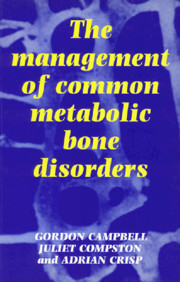2 - Osteoporosis
Published online by Cambridge University Press: 06 July 2010
Summary
Definition, prevalence and epidemiology
Definition
Osteoporosis is characterised by reduced bone mass and by increased risk of fragility fracture. The term osteopenia is used to describe a reduction in bone mass whilst osteoporosis generally denotes the presence of fracture. Fragility fractures are defined as fractures occurring after a fall from standing height or less and may occur without any obvious preceding trauma. The three most common fracture sites in osteoporosis are the spine, the femoral neck and the radius, but fractures may also occur at a number of other sites, particularly the pelvis and humerus.
Prevalence and epidemiology
Fragility fractures constitute an enormous public health problem in the Western world, and are a major cause of morbidity and mortality in the elderly population. In the United Kingdom it is estimated that osteoporosis is responsible for at least 250000 fractures annually, and in the United States the corresponding figure is estimated at 1.3 million. The calculated life-time risk of vertebral fracture in white, post-menopausal women is estimated to be over 30%; for Colles' and hip fracture it is between 10 and 15%. The costs of these fractures to the health services are difficult to quantify accurately but are believed to be at least £500 million in the United Kingdom and $7.3 billion in the USA.
The incidence of fragility fractures increases with age, exponentially for vertebral and hip fractures whilst Colles' fractures plateau around the age of 60.
- Type
- Chapter
- Information
- The Management of Common Metabolic Bone Disorders , pp. 29 - 62Publisher: Cambridge University PressPrint publication year: 1993
- 8
- Cited by



